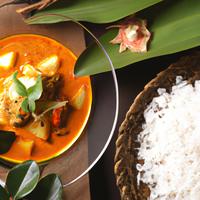
1 serving (350 grams) contains 450 calories, 15.0 grams of protein, 15.0 grams of fat, and 60.0 grams of carbohydrates.

Log this food in SnapCalorie

Nutrition Information
Calories |
304.1 | ||
|---|---|---|---|
% Daily Value* |
|||
| Total Fat | 10.1 g | 12% | |
| Saturated Fat | 5.4 g | 27% | |
| Polyunsaturated Fat | 0 g | ||
| Cholesterol | 6.8 mg | 2% | |
| Sodium | 540.5 mg | 23% | |
| Total Carbohydrates | 40.5 g | 14% | |
| Dietary Fiber | 2.7 g | 9% | |
| Sugars | 5.4 g | ||
| protein | 10.1 g | 20% | |
| Vitamin D | 0 mcg | 0% | |
| Calcium | 33.8 mg | 2% | |
| Iron | 1.4 mg | 7% | |
| Potassium | 270.3 mg | 5% | |
* Percent Daily Values are based on a 2,000 calorie diet. Your daily values may be higher or lower depending on your calorie needs.
Food Attributes
Source of Calories
About Pangang curry with rice
Pangang Curry with Rice is a flavorful Thai dish that combines aromatic red or green curry paste blended with creamy coconut milk, creating a rich, mildly spicy sauce. Typically infused with kaffir lime leaves, this dish features tender protein options, such as chicken, tofu, or shrimp, alongside a medley of vegetables like bell peppers, zucchini, or bamboo shoots. It’s served over steamed jasmine rice, which balances the curry's robust flavors. Originating from Thailand, Pangang Curry highlights the country’s use of fragrant herbs and spices. While it provides healthy fats from coconut milk and nutrients from its vegetables, it can be high in calories and saturated fats depending on the preparation. Those watching sodium intake should note that fish sauce or curry pastes may be salty. Opting for lean proteins and brown rice can enhance its nutritional profile while preserving its authentic taste.



